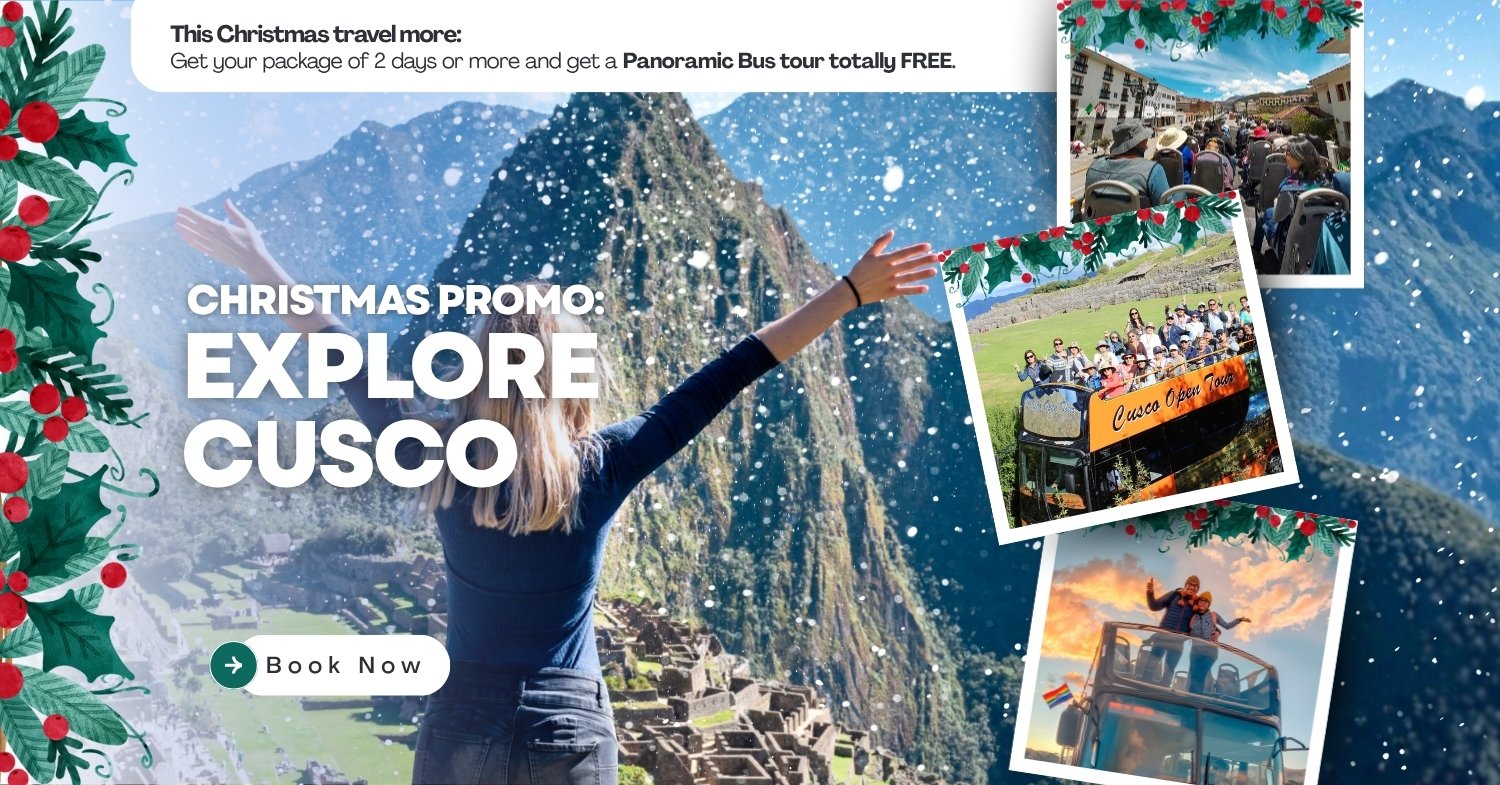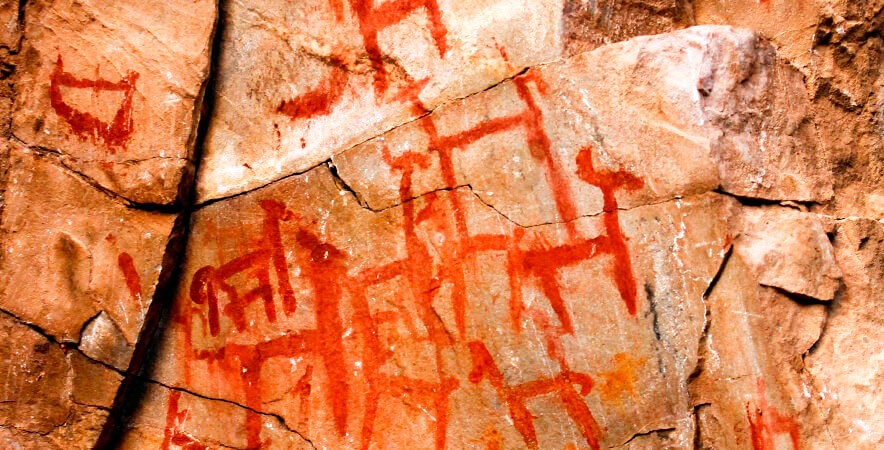

The Sumbay caves, located in the highlands of Arequipa, represent one of the most important legacies of rock art from the Paleolithic period in Peru. This archaeological site is found at an altitude of 4,127 meters above sea level, on the route that connects the city of Arequipa with the Colca canyon, and was recognized as National Cultural Heritage in the year 2000.
The research, led by the archaeologist Máximo Neira since 1968, estimates that the paintings are between 6,000 and 8,000 years old. The caves served as a temporary shelter for the first groups of hunter-gatherers who lived in this puna region, who left a detailed record of their worldview and daily activities on the rock walls.
This guide is designed to provide the essential information (history, cave art and other discoveries at the site) about the art of the Sumbay caves. Next, we will learn about the paintings, the techniques used by their creators, other archaeological findings at the site, and the logistics information needed to plan the visit to this fascinating and important destination in Peru.
Sumbay is located in the department and province of Arequipa, in the Yanahuara district at more than 4000 meters above sea level, about 90 km from the city of Arequipa, it is currently a tourist attraction that is visited by national and foreign tourists who go in search of history. Access is not complicated and you can get there without much problem.

In addition to the pictorial art, excavations at Sumbay have revealed remains of the lithic instruments (stone tools) used by these hunter-gatherers. Analyses have identified two types of tools according to the material: the first worked in retinite stone and the second in obsidian, which shows the techniques they managed for their hunting and processing activities.
To get to the Sumbay Caves, the visitor must take the road that goes from the city of Arequipa towards the Colca Canyon (passing through Pampa de Arrieros). The journey is approximately 80 kilometers to the town of Sumbay, and from there you travel an additional 5 kilometers to the archaeological site.
Entry to the complex is free and there is no fixed visiting schedule. However, due to the altitude and remote location, it is strongly recommended to make the visit in the morning to take advantage of the best natural light and avoid the cold afternoon winds.
The research on the Sumbay caves was started and developed by the Arequipa archaeologist Máximo Neira Avendaño, who began his expeditions in 1968. His studies provided the most detailed analysis of the meaning and technique of this rock art.
Although the complex has several caves, the most important one is identified as SU-3. This main cave holds more than 500 figures, making up the densest art panel at the site. Neira also highlighted cave SU-8, which, although it has very few paintings, contains a scene of great value for research. However, this last one is hard to access, as it is located on a cliff above the Sumbay River.
The big difference between Sumbay and other rock art sites in Peru (like Toquepala or Lauricocha) is the theme of its paintings. In Sumbay, the main scene is not hunting.
Most of the camelids shown (identified by Neira as guanacos, based on color and shape) are not moving or being chased by hunters. Instead, they are shown at rest, in groups, or in rows. This special feature suggests that the paintings were made during a time of social change. They might represent the last phases of the hunter-gatherer period, when these human groups were already in the first stages of domesticating camelids and, possibly, of horticulture (early farming).
Besides the groups of guanacos, other figures of great interpretive value have been identified:
The special feature of Sumbay's art is the main use of the white-cream color. Research determined that this pigment was obtained from the volcanic clay (ash) abundant in the area. To ensure the paintings would last thousands of years on the rock, the artists used a mordant or binder (believed to be animal fat), which allowed the paint to set in a lasting way.
Possibly some of them with the finger and others with a brush, unfortunately there is no clear evidence that they used brushes because absolutely nothing has been found of traces of primitive brushes, which would be the only evidence.
In addition to the paintings, the tips of spears made of stone were found, all expeditions in the Sumbay caves took 02 years in which it was determined that they were inhabited for a thousand years.
To get to the Sumbay Caves from the city of Arequipa, there are three main alternatives.
This is the most direct and flexible option. You must take the highway from Arequipa in the direction of Chivay (Colca Valley). The trip takes approximately between 1 hour and 30 minutes and 2 hours. After passing the Pampa Cañahuas toll booth, you must continue on the route towards Chivay. About 15-20 minutes from that turn-off, you will find a sign that indicates the entrance to Sumbay.
From that point, a dirt road of about 15 minutes leads to the town of Sumbay. There, the local community manages the entrance and charges a fee of S/ 5.00 per visitor. From the town's parking lot, a final 15-minute walk downhill begins on a prepared trail to the main cave.
This is the cheapest alternative, but it requires considerable physical effort and logistics. You must go to the Arequipa Bus Terminal and take a bus or minivan heading to Chivay (Colca Valley). It is essential to ask the driver to drop you off at the Sumbay turn-off, on the main highway. From that point, the traveler must take a walk of approximately 45-60 minutes to the town of Sumbay. For the return, the process is the reverse: you must walk back to the main highway and wait for a bus or minivan that returns to Arequipa, which may not have a fixed schedule.
Several tourism agencies in Arequipa offer this excursion, often combined with other stops on the route to the Colca Canyon. This is the logistically simplest option, as it includes round-trip transport from Arequipa. In addition, it has the advantage of including a professional guide who can explain in detail the history and meaning of the rock art of Sumbay.
This attraction is open to visitors all year round, however in the rainy season, which is from January to March, heavy rainfall makes the entrance road to Sumbay full of puddles since it is a pure trail road. something difficult for visitors who go in their own car and may suffer a breakdown in the cars, that is why at that time it is recommended to visit Sumbay in the mornings. The rest of the year you can schedule your visit as normal.
Outside of the main attraction that are the Caves of Sumbay, you can also visit its traditional town known as a ghost town since the inhabitants who formed the town are not living constantly in the place, they go to their ranches since they They dedicate themselves to the raising of some camelids and when there is a meeting or activity they gather in the town. You will also be able to appreciate its traditional Church and the Train Cemetery. An important detail to keep in mind is that you will not be able to find stores to buy water, cookies, etc. If you plan your visit, it is recommended that you go prepared in terms of food.
Peru offers fascinating experiences that reveal natural landscapes, historical monuments, and living cultures, captivating those who seek adventure and discovery in every corner of its territory. Get to know the most outstanding tours:
Other trips in Peru
If you want to visit Machu Picchu, we recommend you to book your Machu Picchu Entrance Tickets in advance, so you will enjoy your Vacation in Machu Picchu without any problem.